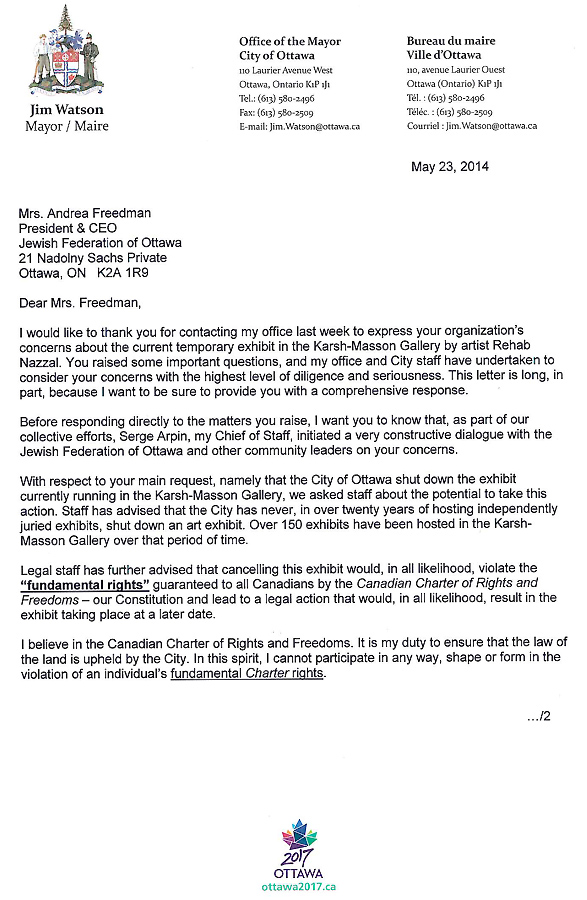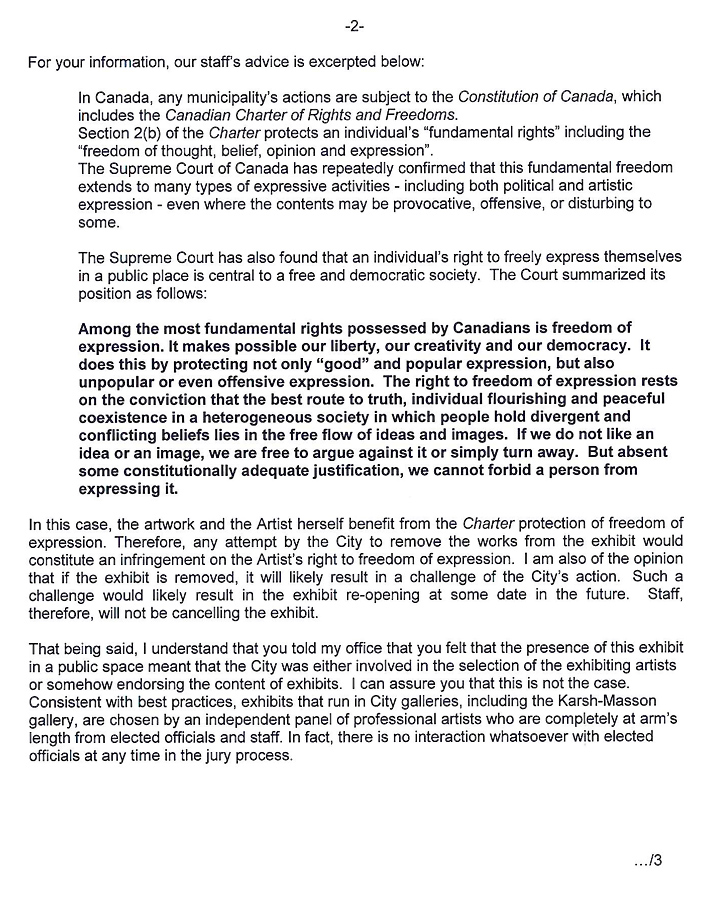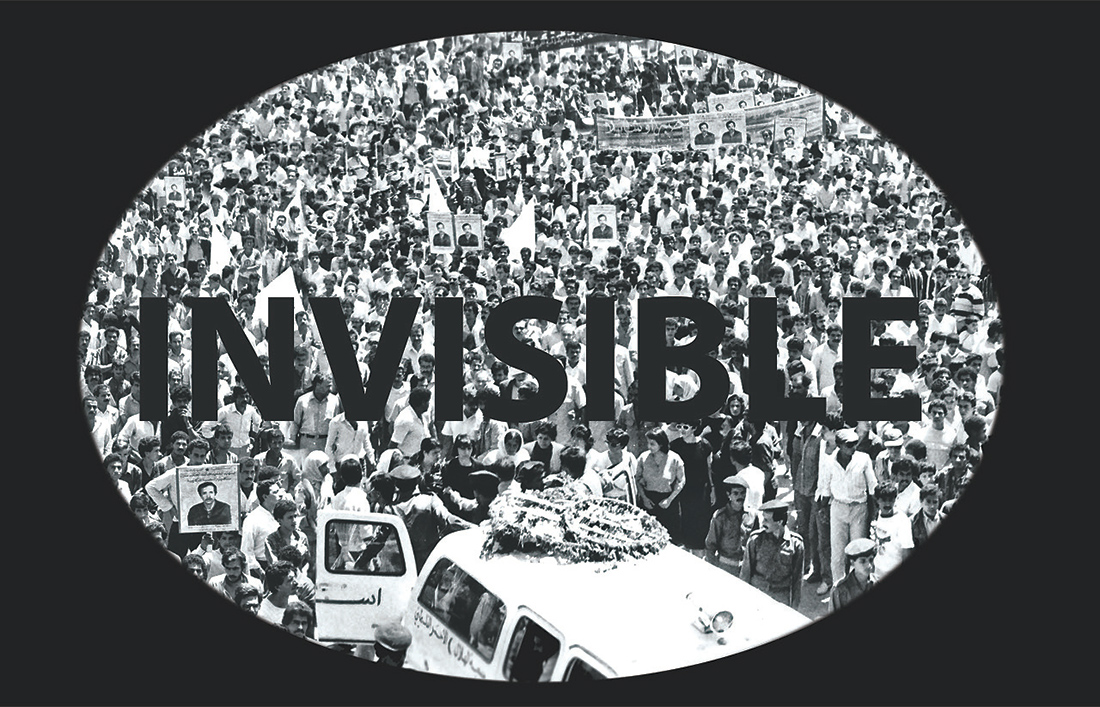
Rehab Nazzal, Mourning (2012). Video, 4:00 minutes.
Rehab Nazzal
CRITICAL ART AND CENSORSHIP
ENCOUNTER OF A PALESTINIAN-CANADIAN ARTIST
Everyone shall have the right to freedom of expression; this right shall include freedom to seek, receive and impart information and ideas of all kinds, regardless of frontiers, either orally, in writing or in print, in the form of art, or through any other media of his choice.
—Article 19, The International Covenant on Civil and Political RightsEveryone has the right freely to participate in the cultural life of the community, to enjoy the arts and to share in scientific advancement and its benefits.
—Article 27, The Universal Declaration of Human Rights
CRITICAL ART OR POLITICAL ART often plays a significant role in disrupting the status quo by challenging systems and structures of power. It can revise and counter the dominant histories of the “victors,” engage with and confront socio-political conditions, and foresee a better world. Critical art has the potential, through its various forms and interventions, to connect, inspire, generate debate, and move people to action. Often the formal strategies that political art uses “ensure the production of a double effect: the readability of a political signification and a sensible or perceptual shock caused, conversely, by the uncanny, by that which resists signification.”1 The protection of freedom of expression as a universal right by the International Covenant on Civil and Political Rights and the Universal Declaration of Human Rights signifies the place that cultural production occupies in society and the risk that this production could face by authoritarian and oppressive powers.
This essay examines the efforts of the state of Israel and Zionist political pressure groups in Canada to suppress freedom of expression regarding the Palestinian narrative and rights. Based mainly on my experiences, on media reports, and art and visual culture scholarship, I argue that interference in the cultural field by Israeli and Zionist political pressure groups constitutes a threat to academic freedom and freedom of expression in Canada and beyond. It also risks delegitimizing and possibly criminalizing freedom of expression on significant social justice issues. I address the zionist groups’ use of the cultural domain to conceal Israel’s violations of international and humanitarian law in Palestine. I recount my experience as a Palestinian Canadian artist facing attacks on, and attempts to censor, my artwork. I detail two specific incidents: my exhibition Invisible at Karsh-Masson Gallery in Ottawa in 2014, and my exhibition Choreographies of Resistance, exhibited at the McIntosh Gallery at Western University in London, Ontario, in 2017.
ART AND FREEDOM OF EXPRESSION
If freedom of expression is about the right to seek, receive, and impart information and ideas of all kinds, and the right to participate in cultural life, then censorship is about suppressing these same rights. It is a direct exercise of coercion to enforce ideology under the pretext of protecting society’s values. Whether it is institutionalised, carried out by totalitarian regimes, or ideologically motivated by agents and groups associated with the state, censorship suppresses the creative process and the public access to artistic and cultural production. The effect of such suppression in a diverse society is even more severe and leads to the degradation of rights and freedoms not only in the cultural field but also in all other fields. The aim of censorship, then, is an attempt to dominate public discourse and legitimize certain voices while silencing others.2
Over the late twentieth century and into the early twenty-first century, censorship has extended beyond state power. With the increasing privatization of public services under neoliberal policies, private groups and corporations have gained noticeable power over the cultural field through what is erroneously called philanthropy and sponsorship. The reliance of art institutions on private funding—even partly—appears to legitimize interference in their programing and activities resulting on dictated standards of inclusion and exclusion. Although states set the rules “of publicly acceptable discourse, of who can speak and what can be said,”3 private political pressure groups, in their association with states, have obtained the power to impose their own standards and ideologies.
In Canada, before September 11, 2001, suppression of freedom of expression on Palestine was invisible in the public sphere. Renowned Canadian artist, Jamelie Hassan, a second generation Lebanese-Canadian, recalls her experience:
Mentioning the word “Palestine” by artists was an issue that puts artists on the defensive side. When a solo exhibition of my work was presented at Museum London (at the time it was called the London Regional Art Gallery) in 1984, Brenda Wallace, the gallery director, was pressured by the board of trustees and by some collectors to cancel my exhibition. Although she did not cancel the show, she did lose her job due to her independent position on many social issues. I personally was attacked by the Globe and Mail art critic John Bentley Mays, who had not seen the show, for my “anti-Zionist” politics, even though my exhibit did not have any work that addressed the Palestine/Israel issue. Subsequently, after several artists came forward to support my work, Mays was forced to readdress his position after seeing the exhibition.4
Hassan and Wallace were attacked because of their beliefs and commitments to social justice. Of course, there are many other undocumented and untold stories of people throughout the country who faced intimidation because of their identity or thoughts on injustices taking place in Palestine.
One of the first attacks on freedom of artistic expression in Canada right after 9/11 occurred when the director of the Canadian Museum of Civilization (now Canadian Museum of History), Victor Rabinovitch, attempted to censor the show, The Lands Within Me: Expressions by Canadian Artists of Arab Origin, an exhibition of 26 Arab Canadian artists. The show, which took Syrian Canadian curator Aida Kaouk five years to organize, was scheduled to open on October 18, 2001. Rabinovitch, in a subjective decision, postponed the exhibition “indefinitely” on the grounds that it lacked “context.”5
An advocacy campaign organized by the exhibiting artists, including Rawi Hage, Jayce Salloum, and Jamelie Hassan, drew media attention and mobilized the public which resulted in the intervention of the then Prime Minister Jean Chrétien during a parliamentary session, forcing Rabinovitch to reverse his decision. The censorship attempt failed, and the show opened as originally scheduled on October 18, what followed, however, was disturbing. After one week, the museum cancelled the position of curator Aida Kaouk after ten years of employment, and the Canadian Jewish Federation and B’nai Brith launched an attack against the installation of Vancouver-based artist Jayce Salloum.6 Salloum’s installation represented Palestinian, Lebanese, and Yugoslavian experiences, and included testimony from a Lebanese woman, Soha Bechara, about her experience in the notorious Khayyam Prison which was operated by Israel during its occupation of South Lebanon. The Zionist groups called Salloum’s work an “inappropriate one-sided promotion of hostility and divisiveness.” “Salloum’s video is not cultural, it is political.”7 His work, these groups claimed, “presents a narrow biased political agenda,” and contains “political propaganda.” They declared that Canada could not afford to allow “the promotion of hatred under the guise of tolerance.”8 Responding to these accusations Salloum wrote:
In the current climate of suppression and repression of any debate and dissention, discursive activities such that art can be, may be one of the few domains left for us to express unpopular ideas, resistance, and the complexities of our lives and the lives of those we choose to identify with …. We have struggled for this space to call our own and it is one that we can still use to champion difference, to provide a heterogeneous engagement with the social and political realities around us, and to facilitate a means of contemplation that can counter the imposition of consent.9
The cancellation of curator Aida Kaouk’s employment contract (she was later transferred to another position), and the cancelation of the Middle Eastern and Southeast Asia programs at the Museum of Civilization were alarming acts representing submission to pressure groups standards. The attack on Salloum’s—one of 26 artists—critical work triggered public debate about freedom of expression and lobbyists interference in public institutions. Media theorist and curator Laura Marks wrote,
It is a gloomy situation when people feel they must ask why Canada should care about oppression and self-determination in other countries. While Canada’s immigration and human rights policies seem ever more sensitive to the needs of global corporations, dissident art like Salloum’s insists that Canadian-ness involves the responsibility to facilitate the global flow of humans, rather than of capital.10
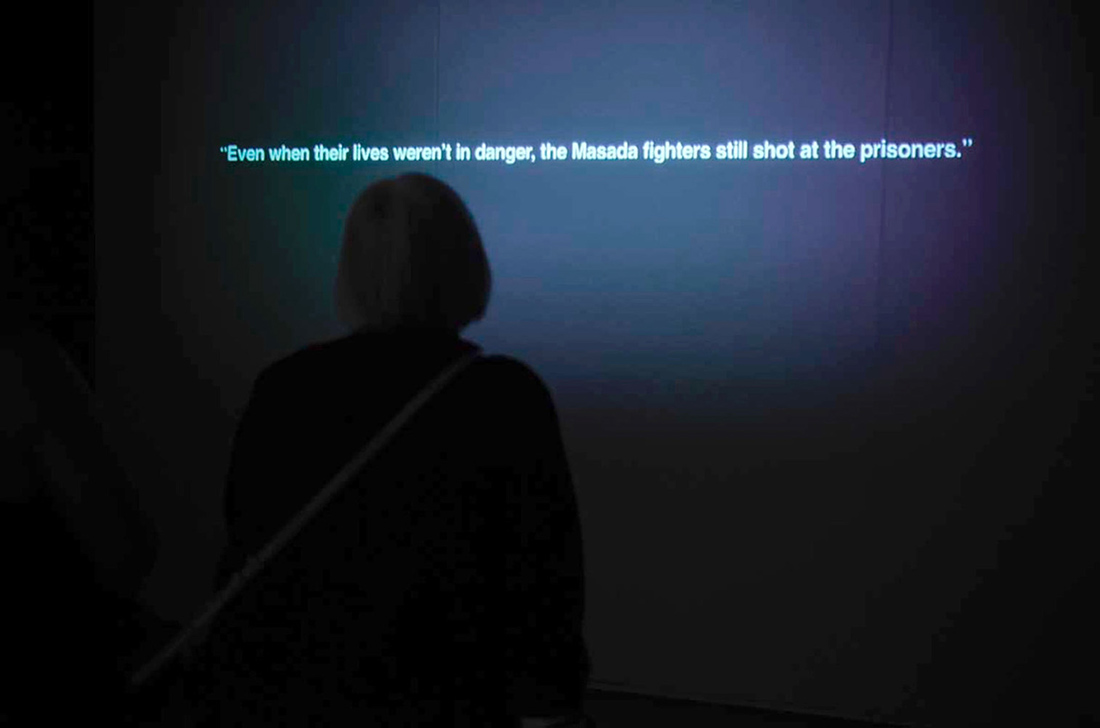
Rehab Nazzal, Military Exercise in the Negev Prison (2014). Installation view, sound, 7:00 minutes.
ISRAELI-ZIONIST ATTEMPTS TO CENSOR THE EXHIBITION INVISIBLE
Attempts to censor or restrict freedom of expression relevant to Israel’s oppression of the Palestinians by zionist political pressure groups become frequent in Canada in the past few years. This section recounts my experience facing the attempts to censor two of my exhibitions, Invisible, 2014 and Choreographies of Resistance, 2017. My intention is to contextualize my experience within the broader struggle against the silencing of Palestinian narratives and the suppression of the rights of countless numbers of artists and academics across the world whose work deals with human rights and the violence of settler colonialism and war. Additionally, sharing my experience will help further reveal the rhetoric and tactics that Zionist groups use to censor art and research pertaining to Palestine.
In 2013, in Ottawa, an arms-length art committee of the Ottawa Public Art Program selected my multimedia installation, Invisible, to be included in the 2014 Karsh-Masson Gallery exhibition schedule. It was not the first time I exhibited my work in Ottawa, a city I have been calling home for over two decades. Everything was proceeding as normal and expected, my exhibition was installed, and a public opening was organized for May 8, 2014. The works in Invisible represented the largely silenced and obscured narratives of human rights violations in occupied Palestine. Particularly, Israel’s extra-judicial assassination of Palestinian intellectuals, leaders, and activists, the abuse of thousands of Palestinian political prisoners, and the suppression of peaceful protests against Israel’s occupation and colonization of Palestinian land. The exhibition included: Military Exercise in Negev Prison (2014), sound, 7:00 min, Mourning (2012), video, 4:00 min, Target (2014), 4:00 min, and Frames from the Negev Prison (2014), photos, as well as 200 photographic prints.
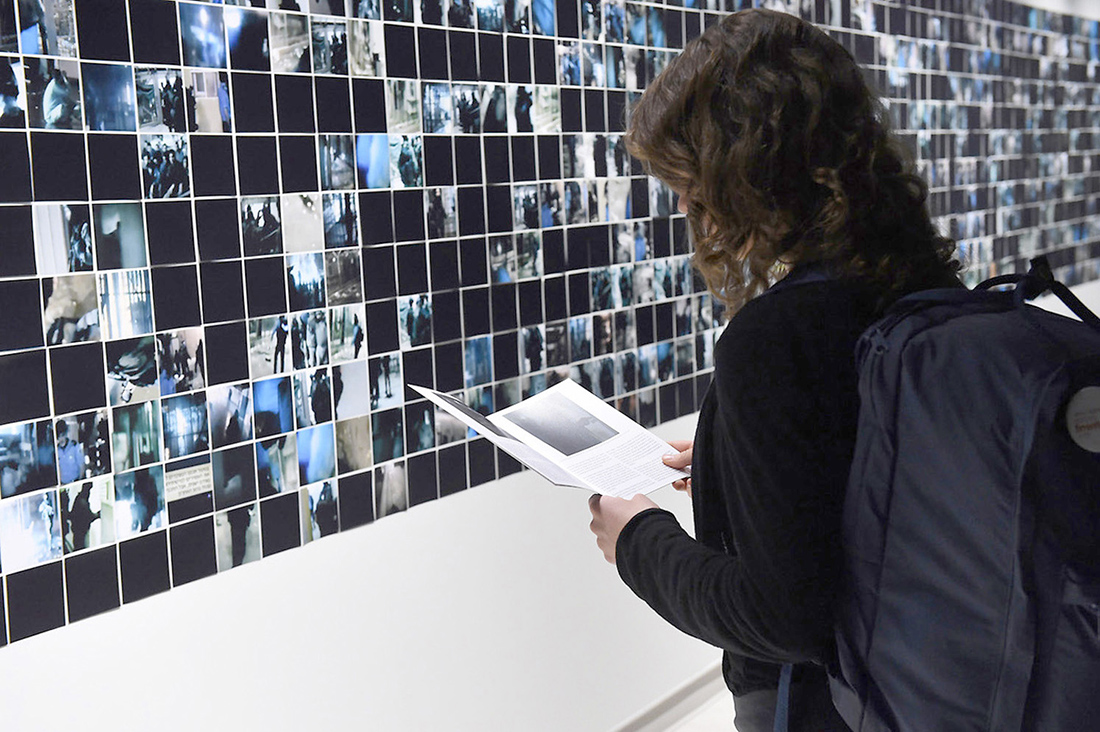
Rehab Nazzal, Frames from the Negev Prison (2014). Installation view during Invisible exhibition, Karsh-Masson Gallery, 2014.
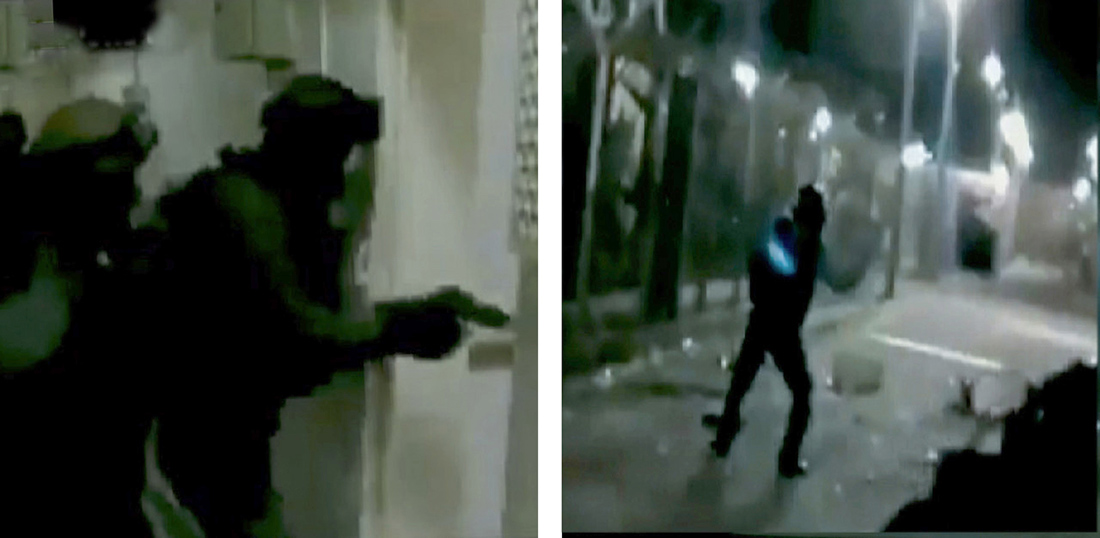
Rehab Nazzal, Frames from the Negev Prison (2014). Detail.
Frames from the Negev Prison, photographs (4×4 inches each), and Military Exercise in the Negev Prison, (2013–2014) depict the Israeli occupation authorities’ horrifying treatment of Palestinian political prisoners in the Negev prison. Negev or Ktsi’ot prison is one of twenty prisons and interrogation centres located inside the state of Israel where Palestinian political prisoners from the West Bank, Gaza, East Jerusalem, and other parts of the country are imprisoned.11 Located in the southern desert of the country, Negev prison is one of the largest prisons, where thousands of Palestinians are held, a great number without charge, trial, or access to legal rights, family visits, health, or education services. Both Frames from the Negev Prison and Military Exercise in the Negev Prison are based on highly censored footage recorded by soldiers and obtained by court order of a military training exercise carried out in the Negev prison after midnight on a day in 2007 by one of Israel’s elite military units while prisoners were asleep.
The training exercise, which according to court documents was aimed at “raising the confidence of the prison guards,”12 resulted in the murder of prisoner Mohamed Al-Ashqar and the injury of dozens of others. Frames from the Negev Prison consists of one thousand images captured from the censored footage, resized into squares and printed alongside another one thousand blank black squares. These prints were exhibited on the gallery wall to create a wall reminiscent of Israel’s Apartheid Wall, which was built with American funds in colonized Palestine. The construction of the wall resulted in the seizing Palestinian land, the confinement of entire communities, and the separation of Palestinians from each other and from life essentials. Viewers from diverse backgrounds can fill these black frames with victims of state and colonial oppression including the assassinated, imprisoned, missing, or kidnapped.
The sound component of Military Exercise in the Negev Prison consists of the audio of the prison invasion and a translated text of the exchange between prisoners and soldiers. It was installed in an enclosed black space within the gallery, causing a haunting effect power disparity and human-human brutality. The third work, Bil’in, is based on footage I recorded while participating in a protest in the village of Bil’in in Ramallah region, against the seizure of 70 percent of its land for Israel’s Apartheid Wall and illegal colonies. In this artwork, sound dominates, recordings of teargas being fired and protesters running and coughing. The artwork combines the recorded sound with an image I created to represent the effect of teargas on protesters’ vision.
Target is a video based on photographs of Palestinian intellectuals and leaders who were extra-judicially assassinated by Israel in multiple locations, including several European and Arab countries and occupied Palestine. The last, Mourning, is a video based on footage from my brother’s funeral in the Yarmouk refugee camp in Damascus, Syria in 1986. My brother, Khalid, was extra-judicially assassinated, in Athens in 1986, at the age of 38 by Israel’s secret agency, Mossad. The agents who killed him entered Greece with fake identification documents and then fled the country after their murderous operation. They have never been brought to justice. This record of his funeral, and the public protest that followed his assassination, was kept intact in my family’s archive for 25 years. In 2011, I broke the silence of the trauma caused by his loss and by Israel’s refusal to allow his body to be buried at home. The result is the silent video Mourning, which shows the outraged crowd, including my parents, siblings, brother’s partner, and his two children. I employed similar formal strategies in the production and display of this video and Target.
Two weeks after the opening of Invisible at Karsh-Masson Gallery, the Israeli ambassador along with Zionist interest groups attacked the show in an attempt to censor it. A campaign of smears and threats began with a closed meeting between the Israeli ambassador to Canada, Rafael Barak, and the mayor of Ottawa, Jim Watson. After the meeting the ambassador attacked the exhibition, claiming “this is not an exhibition that is very candid … it’s something that hides here a message that is very difficult for me, as Israeli ambassador, to accept. It’s a message that is glorifying terrorism.”13 I was shocked by these false allegations, which not only violated my right of freedom of expression but also made me feel as though the Israeli occupation, which has shattered and is still shattering so many lives, had extended to Canada. It brought back difficult memories of my childhood under occupation.
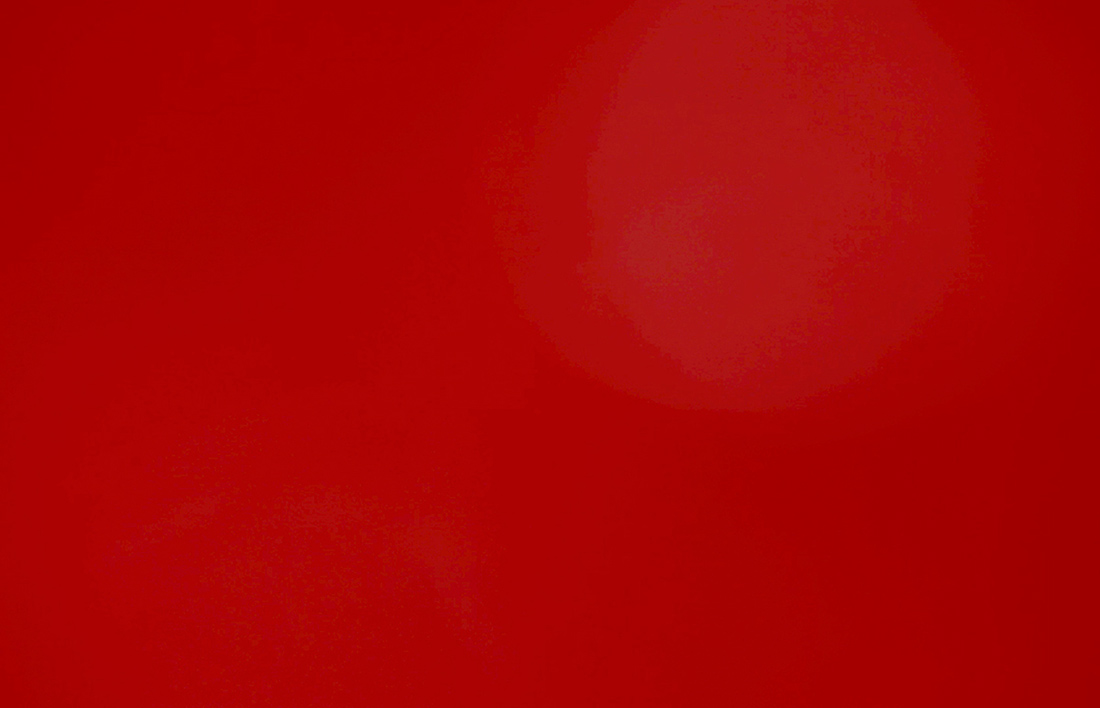
Rehab Nazzal, Bil’in (2010). Video, 4:00 minutes.
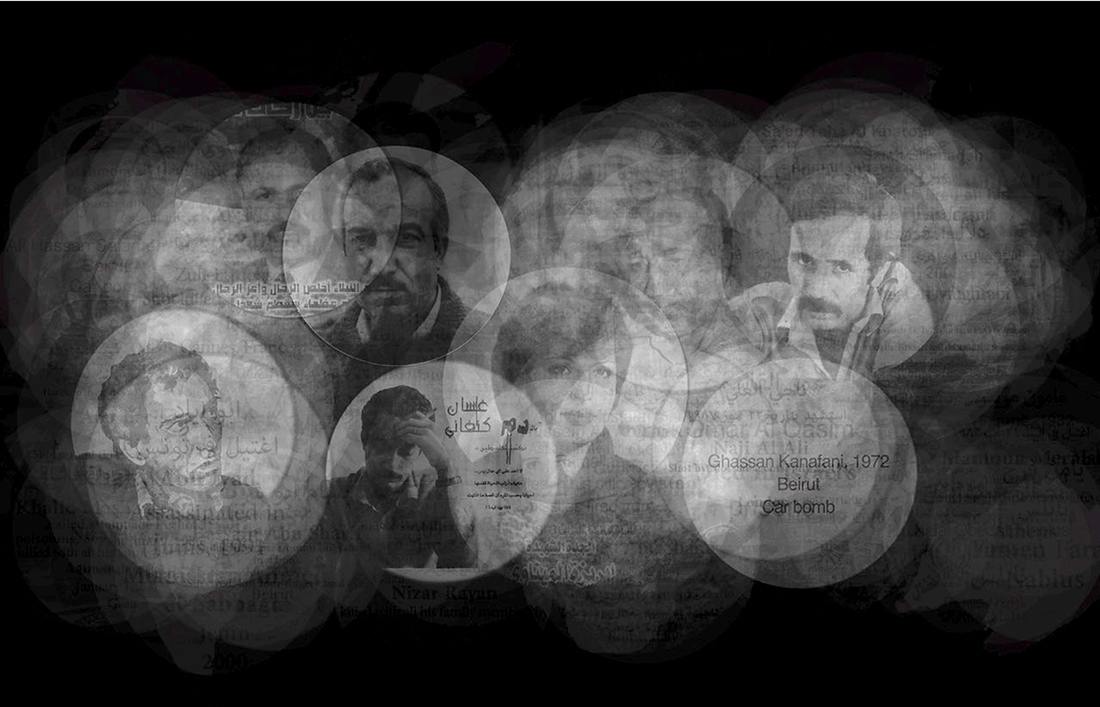
Rehab Nazzal, Target (2012). Video, 4:00 minutes.
Soon after the ambassador’s attack on the exhibition, the Israeli embassy issued a statement with the same accusations and tagging the assassinated Palestinian intellectuals and leaders whose traces of images, appeared on the cover of the exhibition’s brochure as “terrorists.” The attacks spiralled to include the Jewish Federation of Ottawa (JFO) and the Centre for Israel and Jewish Affair (CIJA). Both groups used attack language reflective not only of denial but also of the colonizer orientalist, who views the colonized as less human. Framing Israel as a victim of the people it is colonizing, these groups attacked the exhibition and also the city of Ottawa, the public art program that operates Karsh-Masson Gallery, and the Ontario Arts Council for funding the exhibition. They demanded that the mayor close down the exhibition and called for restrictions on the gallery’s art selection process to prevent artworks such as mine from being shown to the public in the future.14 Such a demand was unprecedented in the history of the gallery and raised serious questions about the extent to which pressure groups will go to suppress narratives with which they disagree.
The mayor, however, defended my rights, based on the Charter of Rights and Freedoms. In his reply to Andrea Freedman, the president of JFO, Mayor Jim Watson, wrote:
[T]he city has never, in over twenty years of hosting independently juried exhibits, shut down an art exhibit …. It is my duty to ensure that the law of the land is upheld by the City. In this spirit, I cannot participate in any way, shape or form in the violation of an individual’s fundamental Charter rights … any attempts by the City to remove the works from the exhibit would constitute an infringement on the Artist’s right to freedom of expression.15
Deputy city manager Steve Kanellakos also responded after being bombarded by the media emphasizing that nothing in the show violated Canadian law and that disliking or disagreeing with any artwork is not unusual. “Art, by its nature, is going to be controversial, depending on your point of view,” he said.16 Kanellakos revealed that the city had “received two emailed complaints, as well as the opinion voiced by Israel’s ambassador to Canada, Rafael Barak.”17 He confirmed that the show would not be closed, asking, “Who gives me the right, or anybody the right, to pull an artist’s work if it’s not breaching some law of the land?”18 The city placed a disclaimer in the gallery indicating that an independent professional art jury selected the exhibition and that the views in the show did not represent the city. However, the mayor did call for a review of the arms-length art selection process at the gallery, revealing the extent of influence of “two emailed complaints and an abjection by a foreign country ambassador”. The process has not changed as of the writing this essay.
Despite the city’s refusal to submit to pressure to close down the exhibition, the campaign of intimidation and accusations intensified and continued for several weeks. Politicians in the Conservative federal government soon got involved. The Minister of State for Democratic Reform, Pierre Poilievre, who claimed that he had seen the exhibition, condemned it in the Canadian Parliament. “Mr. Speaker, I recently saw the exhibit that celebrates notorious terrorists …. As a minister for the National Capital Region and on behalf of the Government of Canada, I condemn this appalling celebration of terrorism in the strongest of terms.”19 For a minister of “democratic reform” to denounce the democratic right of a Canadian citizen ensured by the Canadian Constitution raises serious questions about western democracy. His statement is not surprising, however, considering that the Conservative Party under the leadership of Prime Minister Stephen Harper had shifted Canada’s decades-long foreign policy, which adhered at least “by appearance” to international law pertaining to Palestine- Israel, to blind and unconditional support for Israel. This shift was evident in intensified collaboration between Canada and Israel at many levels including trade, security, and military agreements.20 All of this came at a time when the rule of law and the traditions of upholding human rights in Canada itself were deteriorating. 21
Among the more vicious attacks on Invisible came from the Canadian Senate where Conservative Senator, Linda Frum delivered an inflammatory speech on June 4, 2014 attacking the exhibition. The same day, a segment of that speech was published in the National Post newspaper under the headline: “A Shameful Tribute to Terror, Masquerading as ‘Art’ in Ottawa.” Senator Frum, who claimed she had seen the exhibition, made unfounded accusations entirely removed from the field of art as well as from any historical and political context, portraying an occupying power that has been illegally dispossessing the Palestinian population for decades as a victim:
I know I speak on behalf of all decent and peace-loving Canadians who abhor terror as a means to obtain political ends. For the citizens of Ottawa, this exhibit is a particular travesty since their tax dollars are being used to glorify the murder of innocent civilians …. The mayor of Ottawa, Jim Watson, and his city councillors claim to be powerless to confront this despicable rebuke of Canadian values. They have cast themselves in the roles of defenders of freedom of speech, rather than as enablers of hate.22
Rather than defend a Canadian citizen’s fundamental right of freedom of expression against foreign interference, Frum blindly repeated the Zionist allegations, provoking indignation and hate, and further denied the fact that Israel is a colonizing power that violates international and humanitarian law.23
Israel’s ambassador, Zionist pressure groups, and Canadian Conservative politicians’ attacks on Invisible were reported by Canada’s mainstream news media including the CBC, the National Post, Ottawa Citizen, Montreal Gazette, Maclean’s Magazine, Canadian Art among other local news outlets as well as the Israeli, Arab, and Palestinian media. For the most part, the Canadian and Israeli news media coverage adopted the Zionist narrative, thus spreading Israeli misinformation and intensifying the campaign of intimidation and threats. The city provided me with protection and secured the exhibition after receiving threats. A disturbing piece of propaganda appeared on June 14, 2014 when a full-page ad was published in the Ottawa Citizen condemning the exhibition and the City of Ottawa for not shutting it down and demanding that the city prevent future exhibitions such as mine from being exhibited. The ad read: “The city must never again promote such exhibits, and it must condemn the terrorism this display seeks to sanitize.” Several groups such as the Canadian Coalition Against Terror (C-CAT), the Canadian Taxpayers Federation, International Christian Embassy Jerusalem, and Terrorism and Security Experts of Canada, sponsored the ad. C-CAT’s website displayed a message from then Prime Minister Stephen Harper encouraging debate about “terrorism”: “I commend C-CAT for encouraging a substantive dialogue on terrorism. You have … galvanized divergent groups across the country to unite against those that seek to undermine the cohesiveness of Canadian Society.”
On the other hand, these attacks generated tremendous support and expressions of outrage against such a flagrant interference in an art exhibition. Numerous organizations and community members condemned the Israeli-Zionist-Conservative intrusion on the freedom of expression, including Canadians for Justice and Peace in the Middle East (CJME), Independent Jewish Voices (IJV), Vancouver-based committee, Seriously Free Speech, and Faculty 4 Palestine, among others. The Independent Jewish Voices pointed out in a public statement that the Israel lobby’s tactics intend to:
Deliberately mislead the public and take attention away from the content of the exhibit itself …. This is a familiar tactic of Israel lobby groups in Canada and worldwide. Increasingly fearful of the growing tide of international support for Palestinian human rights, they attempt to silence and even to criminalize this principled support …. We reject the bullying tactics of the Israeli state and its lobby groups such as CIJA and the Jewish Federation.24
Ottawa City Hall received countless letters of support warning of the Zionist threat to the Canadian constitution and the interference of a foreign ambassador in a local art exhibition and questioning the taboo of criticizing the Israeli state for its settler-colonial practices and crimes. Over 120 Canadian and international visual, media arts, and cultural organizations and individuals issued an open letter to the Ottawa mayor and Deputy City Manager. In it, they commended the mayor for protecting “Canadian values of freedom of artistic expression,” and expressed their concerns about the “Israeli Embassy’s attack on these democratic values,” and about the threat to “the long-standing tradition of arms length funding and arms length adjudication developed over many years through the public sector.” And they urged the mayor to protect the independence and transparency of the art selection process.25 In another open letter to mayor Jim Watson and to deputy city manager Steve Kanellakos, 258 organizations and individuals expressed similar concerns about the Zionist lobby’s effort to silence the Palestinian narrative. The signatories noted that the attempt at censorship:
comes at a particularly sensitive time as the Israeli lobby has stepped up its specific and coordinated activities in Canada. This reactionary move is grounded in specious lies about the work on view at Karsh-Masson Gallery as well as the realities on the ground in Palestine … Nazzal, in the tradition of artists who take up the call for social justice, provides a window on her real, grounded experience through her art …. The transparent attempts to silence Rehab Nazzal echo attempts made throughout history to silence the truth when it challenges power.26
Despite the outrage in art and activist communities, over a matter of weeks, claims that my artworks endorsed “terrorism” escalated in intensity. I was first accused of “glorifying terrorism,” then of “celebrating terrorism,” and finally of “memorializing terror.” This misrepresentation, smear campaign, and vilification of my work was staggering. For, if the intention of my works was to shed light on the terror that the Palestinians encounter by illegal colonial military occupation, and on Israel’s non-compliance with international law (including extra-judicial assassinations), how, I wondered, did the work amount to a “celebration, memorialization, or glorification of terror”?
In response to these attacks, the Karsh-Masson Gallery and I called for a public debate. The Ottawa Public Art Program that operates the gallery organized an artist talk on June 1, 2014. The artist talk was moderated by curator Diana Nemiroff, and took place at Ottawa’s St. Brigid’s Centre for the Arts. Individual Zionists were present and attempted to disrupt the event without success.27 Ottawa photographer Justin Wannocott described the event as “one of the most diverse art events he had ever attended in the city.” The “controversy” around the exhibition had mobilized people, including those who had little or no interest in contemporary art.28 The Zionist intimidations and false accusations had transformed the exhibition into a “discursive event” about the role of art that went beyond what the art in question depicted, and it stimulated debates about censorship and the suppression of public discourse on the Palestinian struggle for freedom, equality, and rights.
In an article titled, “Is ‘Terrorism’ Glorified in Art Exhibit in Ottawa City Hall?” the Ottawa Citizen’s art critic Peter Simpson reminded us that, “art by its nature is subjective.” After experiencing the exhibition, Simpson concluded, “What I don’t see is a celebration of terrorism, nor any call for more people to die.”29 In Canadian Art magazine, Diana Nemiroff illuminated the difference between political speech and critical art and warned of the danger of politicians deciding what art Canadians can or cannot see. She emphasized that the public sphere in a democratic society should encompass diverse views. On separating art from politics, Nemiroff reminded readers of the 1982 Applebaum-Hebert Report that stated:
Government serves the social need for order, predictability and control— seeking consensus, establishing norms, and offering uniformity of treatment. Cultural activity, by contrast, thrives on spontaneity and accepts diversity, discord and dissent as natural conditions—and withers if it is legislated or directed …. The cultural sphere, embracing as it does artistic and intellectual activity, has as one of its central functions the critical scrutiny of all other spheres including the political. On this score it cannot be subordinated to the others.30
To exclude the Palestinian experience and deny Canadians the right to be informed of this experience were apparently the aims of those who wished to censor Invisible. In addition to violating the right to self-representation, such attempts infringed on the right to mourn and commemorate. Ottawa writer Michelle Wienroth articulates how our collective memories of atrocities cannot be bounded indefinitely by dominant political powers:
If there are clear victors and losers, the latter’s grief can never be annulled by a sense of retributive justice. War binds the defeated to the recollection of unspeakable tragedy, so unspeakable that it is often silenced by public discourse. Still, in spite of such suppression, collective memory resurfaces in the interstices of aesthetic culture. In art and music, in theatre and dance, the story of war’s victims is revived.31
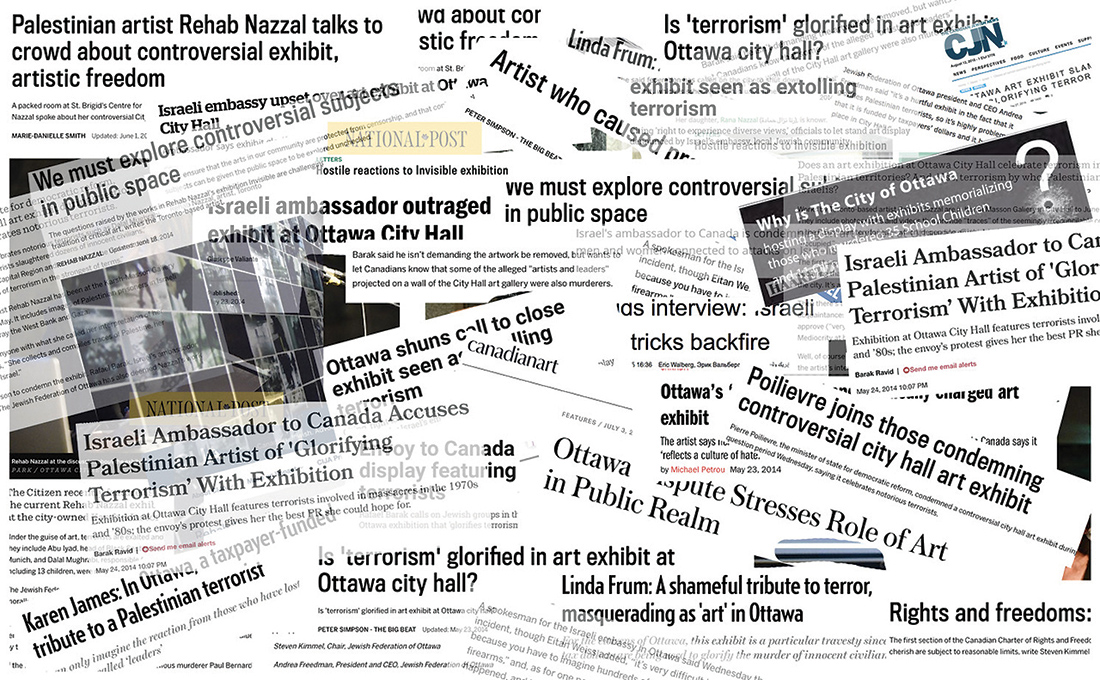
A composite of newspapers clips of articles that were published during the display of Invisible at Ottawa’s Karsh-Masson Gallery, May-June 2014
According to Weinroth, the artist, the exhibition, and what it represents, including the collective trauma of the Nakba, were subjected not only to attempted censorship but also to interrogation. The accusations levelled at my work reflected an extraordinary measure of oppression and denial—the denial of a horrific truth about the Palestinian struggle. The Palestinian people, with no army, locked up in open-air prisons, and facing one of the most militarized settler-colonial states in the world, are subjected to daily assaults and trauma.
Throughout this experience, my encounter with the Canadian mainstream media revealed a troubling trend now dominating Western media. The image of the “Arab,” including Palestinians, as “terrorist” rather than freedom fighters is pervasive and has intensified since September 11, 2001. What my experience revealed, not surprisingly, was the media’s interest in “terrorism” accusations. Reporters, with the exception of a few, recited the Israeli ambassador’s allegation. Many centred their questions on whether my brother, extra-judicially assassinated in Athens by Israel, was a “terrorist.” I tried to draw a distinction between freedom fighters and terrorists, and between colonized peoples’ right to self-defence against settler-colonial oppression, but with no success. I tried to convey the example of freedom fighter Nelson Mandela, who was perceived for decades as a terrorist during the South African struggle for freedom, but again with no result. Very few reporters grasped the danger of political interference in the arts and the threat to freedom of expression. I succeeded only in publishing a short piece in the Ottawa Citizen, which was juxtaposed with a Zionist article, presumably intending to achieve “objectivity” in an inherently unbalanced situation.32
My experience with National Post chief editor Jonathan Kay was most disturbing; it was discreet censorship by the media. The National Post ran two pieces on the subject of my exhibit, in which I was the person under attack. I submitted an opinion editorial responding to Senator Linda Frum’s piece published in June. In an email exchange, Kay wrote on 13 June: “The problem is that your piece contains language and claims—such as the notion that Israel engages in state terrorism … that will immediately cause readers to regard it as a species of fanatical, anti-Zionist propaganda.” Kay here refers to information included in my article, which was based on scholarly works by both Palestinian and Israeli historians, regarding the Nakba, and on reports by various UN organizations. As a condition of publication, Kay proposed to radically modify the article—he cut out key areas, added his view, and recast it to suit his political ideology, distorting the meaning I sought to convey. In my response to him I wrote: “you colonized my message and redesigned it to suit your stance … you have subjected my submission to serious interrogation and constraint.” I refused to sign my name to the article and withdrew my submission.33 This experience with Kay left me questioning Canadian media professionalism, impartiality, and the role of editors in blocking certain views and disseminating others. It also illuminated the false functioning of an open editorial, which is supposed to provide the public with views that are not necessarily held by the newspaper’s editors. Similar to politician Linda Frum’s claims to represent all “decent” Canadians, Jonathan Kay effectively claimed to speak on behalf of all “readers” while controlling op-ed space designated for diverse views.
Some news outlets claimed that I had declined to respond to their questions, which was not true, while others never responded to my request to make my voice heard. After these rejections, I felt that my views and work had been slandered by repeated accusations, and that my efforts at self-defence were continually shut down. Nevertheless, the attempt to censor Invisible failed. In seeking to remove the exhibition from the public’s eye, the pro- Israel lobby ultimately raised its profile, giving it exceptional visibility, a prominence that extended well beyond Ottawa and indeed beyond Canada. The exhibition withstood weeks of relentless assault. Its presence at Ottawa’s Karsh-Masson Gallery left a legacy—the message that art cannot be circumscribed by colonial state power or by political pressure groups, and that significant art is indispensable, especially in times of injustice. It confirmed that art offers a rich field of debate where challenging questions are asked and where suppressed issues are brought to light.
ATTEMPTS TO CENSOR CHOREOGRAPHIES OF RESISTANCE, 2017 EXHIBITION
Three years after the smear campaign and attacks on Invisible, the Zionist political pressure groups in Canada revealed once again their role as agents to the state of Israel. This time my multimedia exhibition, Choreographies of Resistance was attacked. Exhibited at Western University McIntosh Gallery in July 2017, the installation included video, photography and sound. The various works represent my experience in a struggling home country. It focuses on the Palestinian bodies as sites of oppression as well as sites of resistance and offers alternative representation of popular resistance and bodily endurance against weaponry and colonial systems of oppression.
The works in the exhibition were based on an on-the-ground experience in colonized Palestine during a field research trip I conducted in 2015–2016, mainly in the Palestinian city of Bethlehem. At the beginning of my journey, a third Intifada (uprising) erupted, demanding an end to the Israeli military occupation, apartheid, and colonization. During one year on the ground, I witnessed hundreds of protests in tens of locations throughout the West Bank. I was shocked by the excessive use of weapons by the Israeli occupation forces against unarmed civilians resulting in the killing of 300 protesters and injuring tens of thousands. The most painful encounter was witnessing the shooting of two protesters, Mo’taz Zawahiri, 29 (October 13, 2015) and Srour Ahmad Abu Srour, 21 (January 12, 2016) who both died immediately, during protests in downtown Bethlehem, as a result of bullets that pierced their hearts. On December 11, 2015, I was intentionally shot with a .22 calibre bullet by an Israeli sniper while recording a military ‘Skunk”34 truck that was spraying what is called lab-made sewage onto Palestinian homes and workplaces in Bethlehem.35 The ambulance and paramedics who rushed to aid me were then attacked with heavy rounds of teargas, an act that constitutes a violation of the Geneva Convention.
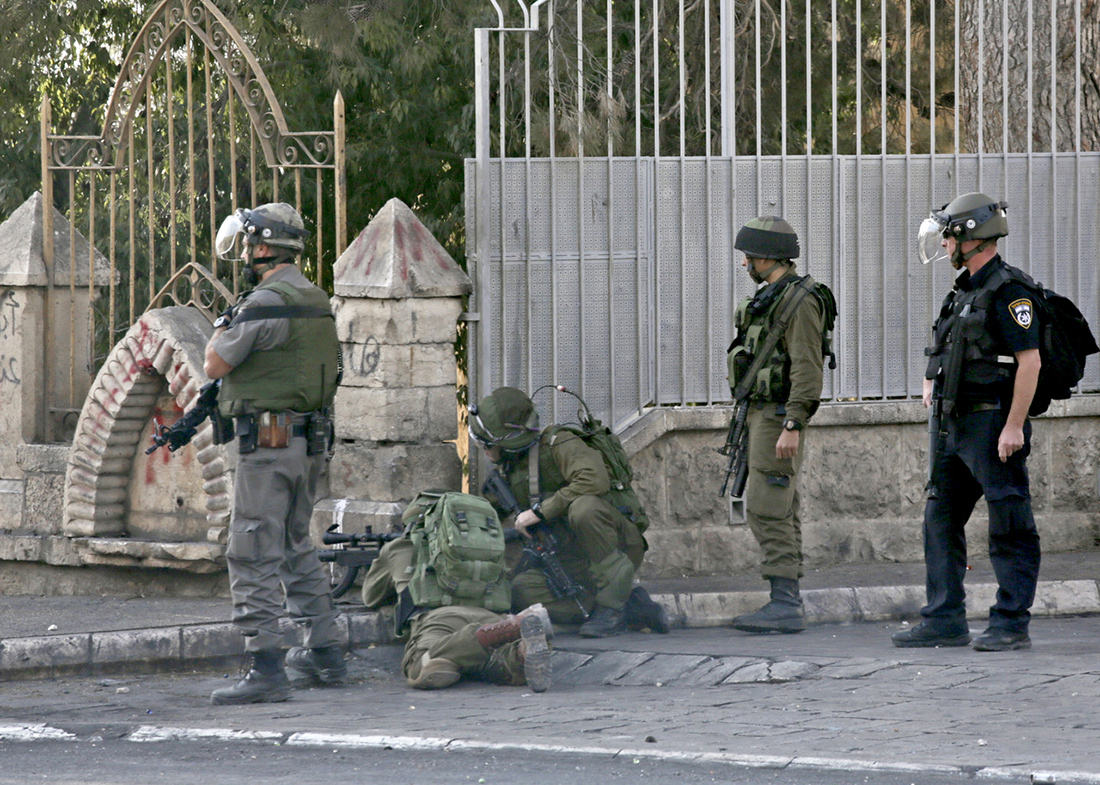
A 2015 photograph by French photographer and activist Anne Pak of Israeli sniper who shot several Palestinian protesters in the same day I was shot.
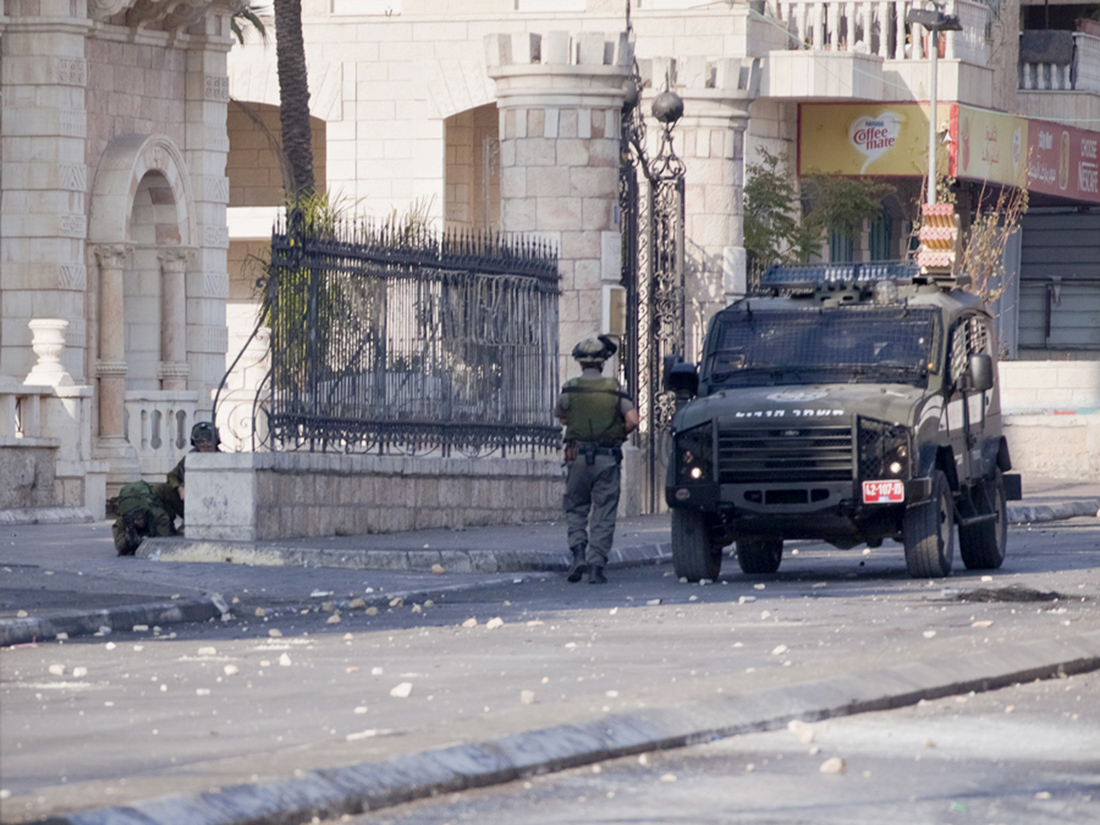
Rehab Nazzal, The last photograph my lens captured showing the Israeli sniper who shot me, on the ground of Jacir’s Hotel entrance. Dec 11, 2015.
Despite the fact that my camera captured a photograph of the Israeli sniper that shot me, the Israeli embassy in Ottawa, which led the attack on my exhibition, Invisible, issued a statement of denial and unfounded claims. The spokesperson of the embassy said: “it’s very difficult to ascertain what happens during a riot, because you have to imagine hundreds of people throwing rocks, Molotov cocktails, using live firearms … it’s very difficult to prove that it ever happened, and it’s very difficult to prove that it didn’t happen.”36 Concealing the truth by portraying protests against illegal military occupation as a “riot,” and claiming that Palestinian protesters use “firearms” is beyond comprehension. The fact is that any local, international, or professional Israeli reporter can testify that the Israeli occupation forces use all forms of weapons against unarmed Palestinian civilians in their own homes, towns, and refugee camps.
Choreographies of Resistance was assaulted two days after its opening at Western University’s McIntosh Gallery. I had not anticipated an attack. I was still healing from my injury and the exhibition was shown in AXENEO7 Gallery in Gatineau/Ottawa months earlier (March–April). Additionally, the assault on Invisible had generated a wide, public protest against Israeli-Zionist censorship. Attempts that, according to many, had backfired. But, once more, it was necessary to defend how I represented my experience. Yet again, I had to defend my freedom of artistic expression against my oppressors and their lobbying groups. This pattern of assault raises three questions: Why is Palestinian self-representation perceived in Western countries as controversial? Why do Western zionist political pressure groups flagrantly and freely attack Western citizens of Palestinian origins? Why do these groups continually impede debates about Palestine/Israel?
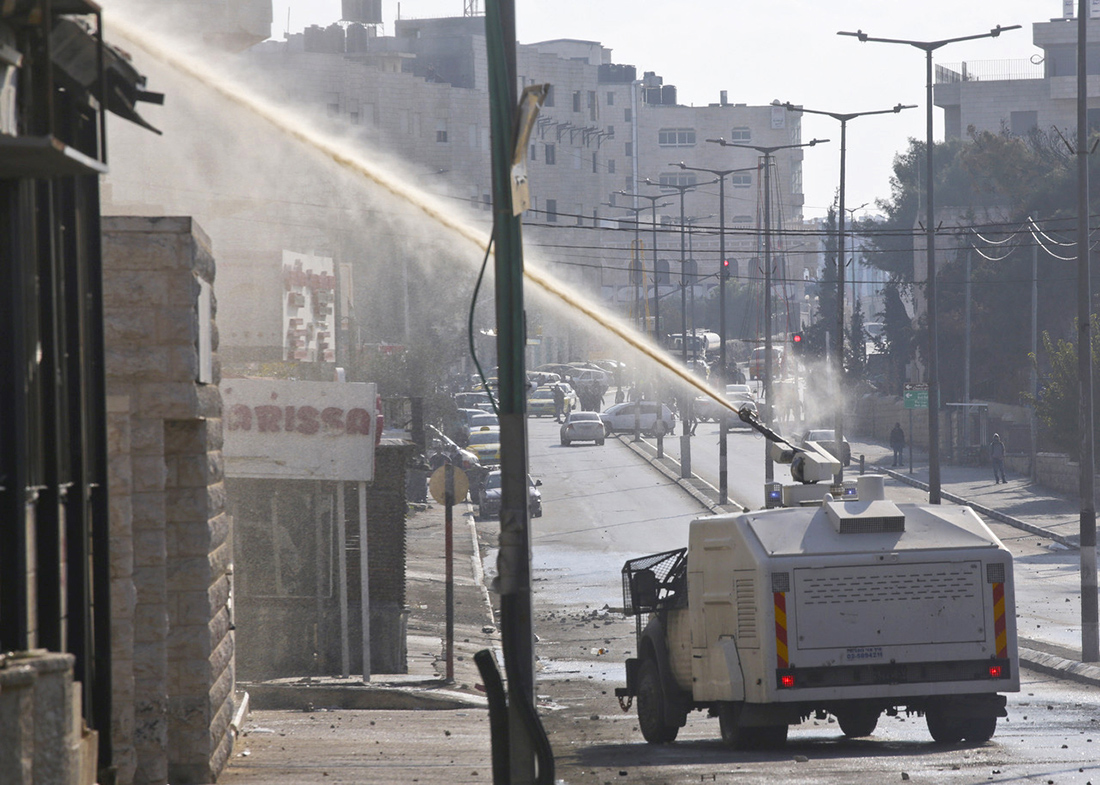
Rehab Nazzal, A “Skunk” truck spraying sewage on Palestinian homes and workplaces in Bethlehem, 2015.
On July 8, 2017, Zionist lobby groups con- demned the exhibition and used rhetoric that mirrored the attack on Invisible. The assaults were mainly led by B’nai Brith, the Centre for Israel and Jewish Affairs, and the Zionist American publication Algemeiner.37 In a statement titled “B’nai Brith Canada Condemns Federal Funding for Anti-Israel Exhibit” (July 10, 2017) the group objected to my representation of the Palestinian popular resistance disregarding Israel’s use of weapons against protesters. It accused Canada’s Social Sciences and Humanities Research Council (SSHRC), which funded my research, of supporting “one-sided projects.” Similarly, Algemeiner, published a provocative article, without integrity, titled “Jewish, Zionist Groups Call for Canadian University to Take Down Art Exhibition Created by Sister of Palestinian Terrorist” (July 12, 2017).38
The smear campaigns focused on my research funding and on my family associations rather than the content and authenticity of my research and artwork. These are well-established tactics that oppressive powers and their agents use against artists and researchers in order to divert the public attention away from the critical content of their works. The attacks on my funding and the right to exhibit my work deny that social research is about creating knowledge, diverse in form and purpose. One of the purposes of critical research is to liberate the discourse around controversial issues and to shift that discourse from the dominant opinion. When rooted in reliable research and documentation, social research aims at “facilitating a critique of social reality, emancipating people … and thus liberating them from oppressive and exploitative social structures.”39 The Zionist pressure groups calling on SSHRC to impose restrictions on the production of, and access to, diverse knowledge not only reflects ignorance of the principles of social research, but is also a blatant call for censorship of research relevant to the ongoing settler colonialism of Palestine. It is apparent that Zionist lobby groups want to conceal the unspeakable and indefensible violations in Palestine, including crimes committed on a daily basis. What I witnessed amounts to war crimes such as the seizure of land and building of Jewish only colonies, murder of protesters, imprisonment and torture of children, attacks on ambulances, evictions of families from their homes in Jerusalem, and the daily torture of Palestinians downtown in the city of Hebron.40
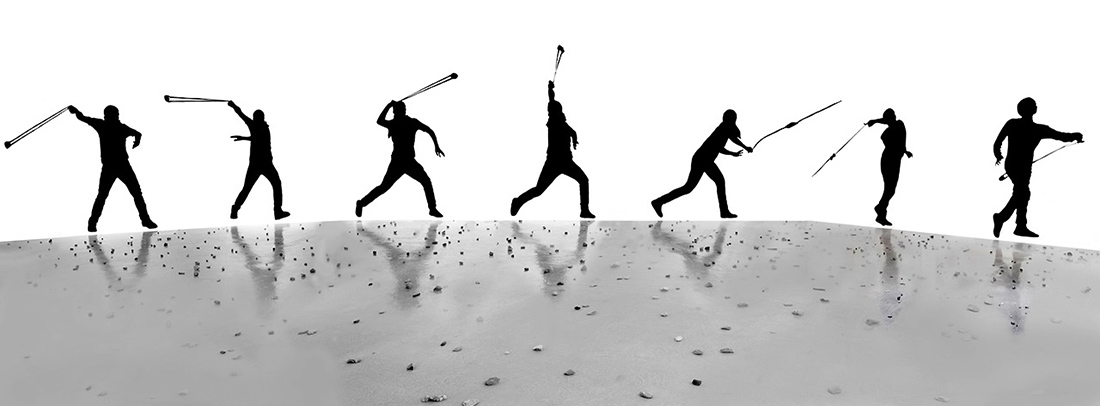
Rehab Nazzal, Resistance Dance (2017). Life-size vinyl prints.
Attacks by political interest groups on freedom of expression and academic freedom not only target Palestinians and non-Palestinians who advocate for Palestinians rights, but also contribute to delegitimizing the struggle of Indigenous people across the world against the long history of settler-colonialism including in Canada. It is not surprising that B’nai Brith’s president objected to the exhibition pamphlet’s reference to similarities between settler-colonial practices against indigenous peoples in both Canada and Palestine.41 The pamphlet also included a symbolic acknowledgment of the land I was then living on (“Western University is situated on the traditional land of the Anishinaabeg, Haudenosaunee, Lunaapeewak and Atawandaron peoples. Western University recognizes the significant historical and contemporary contribution of all the Original Peoples of Turtle Island to the development of Canada”). Such acknowledgment is a first step towards recognizing and resolving the injustices Indigenous people have endured for centuries. Perhaps, in parallel, B’nai Brith’s president fears recognition of the Nakba and the Palestinian refugees’ right of return as first steps towards justice in Palestine/Israel.
With the support of my advisory committee, my lawyer Dimitri Lascaris, activist and artist communities, human rights groups, and the McIntosh Gallery, Western University did not succumb to the Zionist pressure. In one of the letters sent to the gallery and university administration, Thomas Woodley, president of Canadians for Justice and Peace in the Middle East (CJPME), stressed the significant role art plays in countering dominant narratives and breaking prejudices. He wrote:
Such exhibits are essential for the Canadian public to be exposed to alternative global narratives and viewpoints. In Canada and the West, because of historical and cultural biases, certain viewpoints dominate, and others rarely heard. Hosting exhibits like that of Ms. Nazzal help Canadians get out of their bubble and see life and world events differently.
In a letter to Western president Amit Chakma and Vice-President (Academic) Janice Deakin (July 17), I wrote:
I ask that you publicly defend my right to exhibit my work without the interference from pressure groups, whether internal or external to the university …. In defending the legitimacy and integrity of my academic performance (most notably my exhibition), you will defend not only SSHRC’s academic legitimacy and integrity, but also that of Western University itself. This, I believe, will be in everyone’s interest.
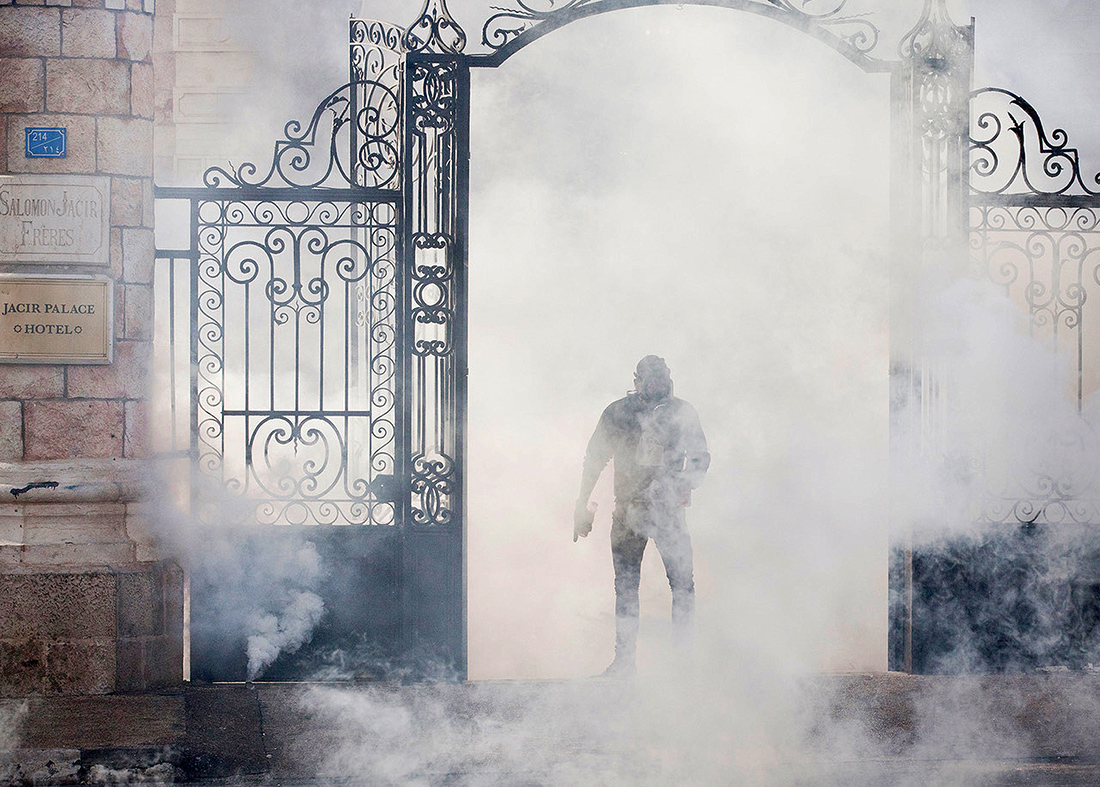
Rehab Nazzal, Photophobia series (2015–2016). Photo #2, mounted on dibond, 121.9 x 86.3 cm.
Although the attack was public, Western University’s president and vice-president were reluctant to issue a public response. The office of the president and provost responded to my letter (18/7/2017):
Please know that we have been responding directly and accordingly to any critics and supporters of your exhibition who have written to us to express their views. We have taken these opportunities to highlight the rigorous academic process through which your artwork and scholarship has been vetted; to underline the principle of academic freedom which is core to our institution; and to emphasize Western’s commitment to maintaining a safe and respectful learning and work environment in which all students, staff and faculty can aspire to excellence and success.
Academic freedom and freedom of expression should be publicly protected and forcefully defended, and art and academic works should generate debate and engage the public on various socio-political issues. Human rights violations should be everyone’s concern.
My experience with these two exhibitions is not dissimilar to the intimidation, assault, deprivation of jobs and funding, personal attacks, media assaults, and vilifications of work that numerous well-known—but mostly unknown—individuals, including academics, artists, and activists, have faced and are still facing in Canada in the US in particular. I am one of a great number of artists and scholars who had to defend their right to share their research and artwork in the public sphere.
Paradoxically, despite all efforts to suppress my freedom of artistic expression and the more intense the attacks become, the more visible the subjects I represent become and the more such attacks create awareness and generate support and solidarity.
Art and culture embody the collective experiences of people, defy erasure, and survive human atrocities and oppression regardless of attempts to eliminate, destroy, appropriate, or censor. Expressions of people’s experiences and their collective memories emerge in various creative forms. Attempts to censor or to use the arts for political propaganda are fleeting, even if they temporarily appear to succeed, and often end with demolishing of colonial, discriminatory, or authoritarian systems. Derogatory rhetoric used to create controversy, infuse and inflame discrimination, and conceal injustices generally fails regardless of the effort and resources used. Art and culture overpower oppression.
Zionist attempts to suppress Palestinian freedom of expression are not disconnected from the objectives of the settler colonial project that targets Palestinian life, land, culture and narrative.
Notes
- 1 Jacques Rancière, “The Politics of Aesthetics: The Distribution of the Sensible,” trans. Gabriel Rockhill (London: Continuum, 2004), 63.
- 2 Allan K. McDougall and Lisa Philips Valentine, “Selective Marginalization of Aboriginal Voices: Censorship in Public Performance,” in Interpreting Censorship in Canada, eds. Klaus Peterson and Allan C. Hutchinson (Toronto: University of Toronto Press, 1999), 403.
- 3 Reg Whitaker, “Chameleon on a Changing Background: The Politics of Censorship in Canada,” in Interpreting Censorship in Canada, eds. Klaus Peterson and Allan C. Hutchinson (Toronto: University of Toronto Press, 1999), 36.
- 4 The author’s interview with artist Jamelie Hassan, London, Ontario, August 2017.
- 5 Hugh Winsor, “Uncivilized behaviour for a museum,” The Globe and Mail, September 28, 2001, https://www.theglobeandmail.com/news/national/uncivilized-behaviour-for-a-museum/article1339038/.
- 6 John Dirlik, “Canadian Museum Decision, Reversal Angers Both Arab and Jews,” Washington Report on Middle East Affairs, January/February 2002, https://www.wrmea.org/002-january-february/
- canadian- museum-decision-reversal-angers-both-arabs-jews.html.
- 7 Jayce Salloum, “Everything and Nothing, or Art and the Politics of ‘War’,” Fuse Magazine 24.4, (December 2001).
- 8 Ibid.
- 9 Ibid.
- 10 Laura Marks, “Citizen Salloum,” Fuse Magazine 26.3 (August 2003): 19.
- 11 See Prisoner Support and Human Rights Association, “Prisons and Detention Centers,” addameer.org, http://www.addameer.org/prisons-and-detention-centers (accessed March 1, 2018).
- 12 The Israeli military order of the invasion of the Negev prison, released by the court, included “raising the moral of the prison guards “as one its purposes. See International Middle East Media Centre, War Crimes against Palestinian Prisoners Committed by Israeli Special Units, January 25, 2015, http://imemc.org/article/70358/.
- 13 Carys Mills & Marie-Danielle Smith, “City hall art exhibit provokes war of words between Israeli, Palestinian representatives,” Ottawa Citizen, May 23, 2014, https://ottawacitizen.com/news/local-news/israeli-embassy-says-city-hall-art-display-glories-terror.
- 14 Carys Mills, “Ottawa Jewish Federation condemns art exhibit at City Hall,” Ottawa Citizen, May 22, 2014, https://ottawacitizen.com/news/local-news/ottawa-jewish-federation-condemns-art-exhibit-at-city-hall.
- 15 Ottawa Mayor Jim Watson’s letter to the Jewish Federation of Ottawa, May 23, 2014, see APPENDIX I.
- 16 Carys Mills, “Ottawa Jewish Federation Condemns Art Exhibit at City Hall,” Ottawa Citizen, May 22, 2014, http://ottawacitizen.com/news/local-news/ottawa-jewish-federation-condemns-art-exhibit-at-city-hall.
- 17 Ibid.
- 18 Ibid.
- 19 Andrew Nguyen, “Poilievre Joins those Condemning Controversial City Hall Art Exhibit,” Ottawa Citizen, June 4, 2014, http://ottawacitizen.com/news/local-news/poilievre-joins-those-condemning-controversial- city-hall-art-exhibit.
- 20 For example, the Canada-Israel Free Trade Agreement (see http://international.gc.ca/trade-commerce/trade-agreements-accords-commerciaux/agr-acc/israel/fta-ale/background-contexte.aspx?lang=eng; and the Canada-Israel strategic partnership (see, http://www.international.gc.ca/name- anmo/canada_israel_MOU-prot_ent_canada_israel.aspx?lang=eng).
- 21 Some examples of deteriorating civil liberties and human rights in Canada, particularly under the previous Conservative government, include the approval of Bill C-51, which allows the state to detain “terrorism” suspects based on secret evidence; the cases of Maher Arrar, Abdullah Almalki, Ahmad El Maati, and Muayyed Nureddin, who were imprisoned and tortured in Syria and Egypt based on false information provided to the US authorities and to authoritive regimes in their countries of origin; and, most disturbingly, the case of the child Omar Khadr, who was held and tortured in Guantanamo Bay prison and abandoned by the Canadian government.
- 22 “Linda Frum: A Shameful Tribute to Terror Masquerading as ‘art’ in Ottawa,” The National Post, June 4, 2014, http://nationalpost.com/opinion/linda-frum-a-shameful-tribute-to-terror-masquerading-as-art-in-ottawa.
- 23 The United Nations Security Council and General Assembly have adopted hundreds of resolutions demanding an end to Israel’s illegal acts, including the military occupation of the West Bank and Gaza, confirming refugees’ right of return, end of land seizures and the building settlements, an end to house demolitions and the disproportionate use of military power, an end to deportations, imprisonment, and torture including of children, and an end to collective punishment, among other countless demands and condemnations.
- 24 Independent Jewish Voices Canada (IJV), “Statement on the Exhibit “Invisible” and the Public’s Reaction,” May 2014, http://ijvcanada.org/2014/independent-jewish-voices-statement-on-the-exhibit-invisible-and-the-publics-reaction/.
- 25 Open letter to Mayor Jim Watson and Deputy City Manager Steve Kanellakos, May 29, http://opinionware.net/invisible/Letter-to-Ottawa-Supporting-Rehab-Nazzal.pdf.
- 27 Marie-Danielle Smith, “Palestinian Artist Rehab Nazzal Talks to Crowd about Controversial Exhibit, Artistic Freedom,” Ottawa Citizen, June, 1, 2014.
- 28 David Lorge Parnas, “Viewing the ‘Invisible’ exhibit at Ottawa City Hall was a Moving Experience; Before you Judge City Hall Exhibit, Go View It,” Ottawa Citizen, May 26, 2014, http://ottawacitizen.com/opinion/letters/before-you-judge-city-hall-exhibit-go-view-it.
- 29 Peter Simpson, “Is ‘Terrorism’ Glorified in Art Exhibit at Ottawa City Hall?” Ottawa Citizen, May 23, 2017, http://ottawacitizen.com/entertainment/local-arts/is-terrorism-glorified-in-art-exhibit-at-ottawa-city-hall.
- 30 Diana Nemiroff, “Ottawa Dispute Stresses Role of Art in Public Realm,” Canadian Art, July 3, 2014.
- 31 Michelle Wienroth, “Palestinian Art Exhibit Under Siege Seeks Free Expression,” Rabble.ca, June 2, 2014.
- 32 Rehab Nazzal, “We Must Explore Controversial Subjects in Public Space,” Ottawa Citizen, June 18, 2014, http://ottawacitizen.com/opinion/letters/we-must-explore-controversial-subjects-in-public-space.
- 33 See email correspondence with Jonathan Kay in APPENDIX II.
- 34 A Skunk is an Israeli-invented weapon consisting of a yellow, horrible-smelling liquid, sprayed by water cannon on Palestinian protesters and their residences.
- 35 Nazzal, Rehab, “Opinion: Sniper’s bullet raises questions for PhD candidate,” January 7, 2016, http://news.westernu.ca/2016/01/nazzal/; Canadian Art, December 15, 2018 https://canadianart.ca/news/rehab-nazzal-shot-in-west-bank/.
- 36 Simpson, Peter, “Artist who caused protest in Ottawa shot in Bethlehem,” December 16, 2015, https://ottawacitizen.com/entertainment/local-arts/artist-who-caused-protests-in-ottawa-shot-in-bethlehem.
- 37 “Prime Minister’s Office Hires Rightist Israel Advocacy Group for 1 Million Shekels,” Haaretz, January 13, 2015, http://www.haaretz.com/israel-news/.premium-1.636953.
- 38 Rachel Former, “Jewish, Zionist Groups Call for Canadian University to Take Down Art Exhibit Created by Sister of Palestinian Terrorist,” January 12, 2017, https://www.algemeiner.com/2017/07/12/jewish-zionist-groups-call-for-canadian-university-to-take-down-art-exhibit-created-by-sister-of-palestinian-terrorist/.
- 39 Sotirios Sarantakos, Social Research (London: Palgrave Macmillan, 2012), 11.
- 40 See multiple UN reports including United Nations Economic and Social Commission for Western Asia (ESCWA) Report, 2017; Human Rights Watch report, “Occupation, Inc.,” January 19, 2016; and Defense for Children International, Palestine, http://www.dci-palestine.org/news, among others.
- 41 Choreographies of Resistance exhibition brochure.
APPENDIX 1
